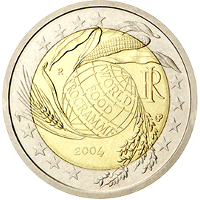 |
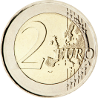 |
C o m m e m o r a t i v e
C o i n s |
||
| Italien | |||||||
The edge embossing on the Italian 2‐Euro‐commemorative coins is : |
 |
||||||
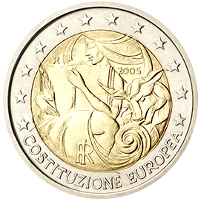
|
 |
Italy | 1st anniversary of the signing of the European Constitution | 20001 |  |
Volume : 18,000,000 Date of Issue : 29 Oct. 2005 Designer : Maria Carmela Colaneri ("M.C.C.") Producer : Italian mint Istituto Poligrafico e Zecca dello Stato in Rome (Mintmark = "R") |
|||||

|
 |
Italy | Winter Olympics in Turin 2006 | 20001 |  |
Volume : 40,000,000 Date of Issue : 10 Feb. 2006 Designer : Maria Carmela Colaneri ("M.C.C.") Producer : Italian mint Istituto Poligrafico e Zecca dello Stato in Rome (Mintmark = "R") |
|||||
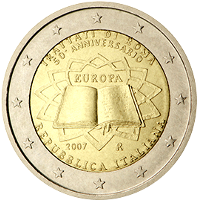
|
 |
Italy | 50th anniversary of the Signature of the Treaty of Rome | 20001 |
 |
Volume : 5,000,000 Date of Issue : 25 Mar. 2007 Designer : Helmut Andexlinger Producer : Italian mint Istituto Poligrafico e Zecca dello Stato in Rome (Mintmark = "R") |
|||||
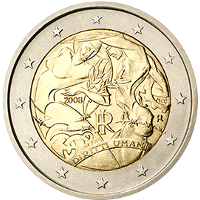
|
 |
Italy | 60th anniversary of the Universal Declaration of Human Rights | 20001 |  |
Volume : 2,500,000 Date of Issue : 10 Dec. 2008 Designer : Maria Carmela Colaneri ("MCC") Producer : Italian mint Istituto Poligrafico e Zecca dello Stato in Rome (Mintmark = "R") |
|||||
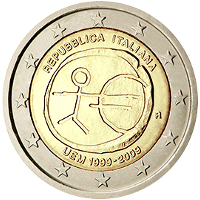
|
 |
Italy | 10 years of Economic and Monetary Union (EMU) | 20001 |
 |
Volume : 2,000,500 Date of Issue : 26 Mar. 2009 Designer : Georgios Stamatopoulos ("ΓΣ") Producer : Italian mint Istituto Poligrafico e Zecca dello Stato in Rome (Mintmark = "R") |
|||||
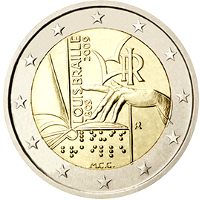
|
 |
Italy | 200th birthday of Louis Braille | 20001 |  |
Volume : 2,000,000 Date of Issue : 15 Oct. 2009 Designer : Maria Carmela Colaneri ("M.C.C.") Producer : Italian mint Istituto Poligrafico e Zecca dello Stato in Rome (Mintmark = "R") |
|||||
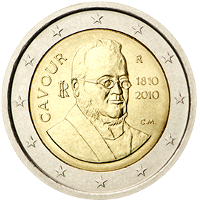
|
 |
Italy | 200th birthday of Camillo Benso, conte di Cavour | 20001 |  |
Volume : 4,000,000 Date of Issue : 24 Sep. 2010 Designer : Claudia Momoni ("C.M.") Producer : Italian mint Istituto Poligrafico e Zecca dello Stato in Rome (Mintmark = "R") |
|||||

|
 |
Italy | 150th anniversary of Italian unification | 20001 |  |
Volume : 10,000,000 Date of Issue : 22 Apr. 2011 Designer : Ettore Lorenzo Frapiccini ("ELF INC." ‐ INC. = Incisore / Engraver) Producer : Italian mint Istituto Poligrafico e Zecca dello Stato in Rome (Mintmark = "R") |
|||||
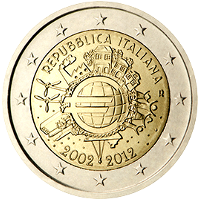
|
 |
Italy | 10 years Euro‐Currency | 20001 |
 |
Volume : 15,000,000 Date of Issue : 20 Mar. 2012 Designer : Helmut Andexlinger Producer : Italian mint Istituto Poligrafico e Zecca dello Stato in Rome (Mintmark = "R") |
|||||
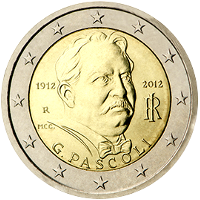
|
 |
Italy | 100th anniversary of the death of Giovanni Pascoli | 20001 |  |
Volume : 15,000,000 Date of Issue : 18 Jul. 2012 Designer : Maria Carmela Colaneri ("M.C.C.") Producer : Italian mint Istituto Poligrafico e Zecca dello Stato in Rome (Mintmark = "R") |
|||||
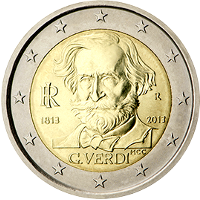
|
 |
Italy | 200th birthday of Giuseppe Verdi | 20001 |  |
Volume : 10,000,000 Date of Issue : 20 May 2013 Designer : Maria Carmela Colaneri ("MCC") Producer : Italian mint Istituto Poligrafico e Zecca dello Stato in Rome (Mintmark = "R") |
|||||
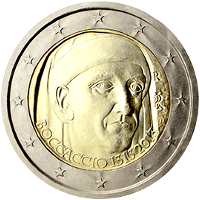
|
 |
Italy | 700th birthday of Giovanni Boccaccio | 20001 |  |
Volume : 10,000,000 Date of Issue : 25 Jul. 2013 Designer : Roberto Mauri ("m") Producer : Italian mint Istituto Poligrafico e Zecca dello Stato in Rome (Mintmark = "R") |
|||||
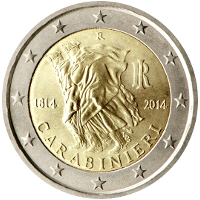
|
 |
Italy | 200th anniversari of the Carabinieri | 20001 |  |
Volume : 6,525,000 Date of Issue : 25 Mar. 2014 Designer : Luciana De Simoni ("LDS") Producer : Italian mint Istituto Poligrafico e Zecca dello Stato in Rome (Mintmark = "R") |
|||||
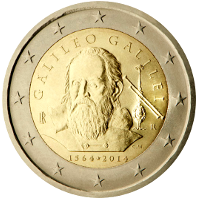
|
 |
Italy | 450th birthday of Galileo Galilei | 20001 |  |
Volume : 6,529,820 Date of Issue : 17 Jun. 2014 Designer : Claudia Momoni ("C.M.") Producer : Italian mint Istituto Poligrafico e Zecca dello Stato in Rome (Mintmark = "R") |
|||||
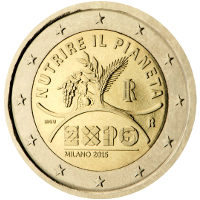
|
 |
Italy | EXPO 2015 in Milan | 20001 |  |
Volume : 3,554,820 Date of Issue : 29 Apr. 2015 Designer : Maria Grazia Urbani ("MGU") Producer : Italian mint Istituto Poligrafico e Zecca dello Stato in Rome (Mintmark = "R") |
|||||
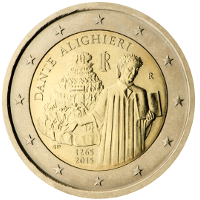
|
 |
Italy | 750th birthday of Dante Alighieri | 20001 |  |
Volume : 3,515,000 Date of Issue : 26 Jun. 2015 Designer : Silvia Petrassi ("SP") Producer : Italian mint Istituto Poligrafico e Zecca dello Stato in Rome (Mintmark = "R") |
|||||

|
 |
Italy | 30 years EU‐Flag | 20001 |
 |
Volume : 1,005,000 Date of Issue : 09 Nov. 2015 Designer : Georgios Stamatopoulos ("ΓΣ") Producer : Italian mint Istituto Poligrafico e Zecca dello Stato in Rome (Mintmark = "R") |
|||||
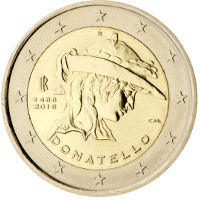
|
 |
Italy | 550 years since the death of Donatello | 20001 |  |
Volume : 1,500,000 Date of Issue : 29 Apr. 2016 Designer : Claudia Momoni ("C.M.") Producer : Italian mint Istituto Poligrafico e Zecca dello Stato in Rome (Mintmark = "R") |
|||||
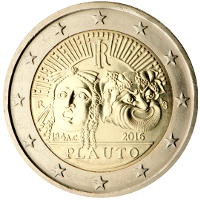
|
 |
Italy | 2200th anniversary of the death of Titus Maccius Plautus | 20001 |  |
Volume : 1,500,000 Date of Issue : 16 May 2016 Designer : Luciana De Simoni ("LDS") Producer : Italian mint Istituto Poligrafico e Zecca dello Stato in Rome (Mintmark = "R") |
|||||
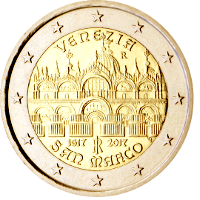
|
 |
Italy | 400th anniversary of the completion of the Basilica San Marco in Venice | 20001 |  |
Volume : 1,500,000 Date of Issue : 22 Mar. 2017 Designer : Luciana De Simoni ("LDS") Producer : Italian mint Istituto Poligrafico e Zecca dello Stato in Rome (Mintmark = "R") |
|||||
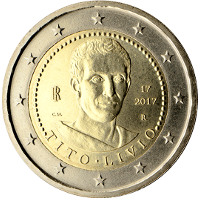
|
 |
Italy | Bimillenary of the death of Titus Livius | 20001 |  |
Volume : 1,500,000 Date of Issue : 23 Jun. 2017 Designer : Claudia Momoni ("C.M.") Producer : Italian mint Istituto Poligrafico e Zecca dello Stato in Rome (Mintmark = "R") |
|||||
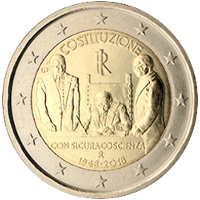
|
 |
Italy | 70 years Constitition of Italy | 20001 |  |
Volume : 4,000,000 Date of Issue : 02 Jan. 2018 Designer : Uliana Pernazza ("UP") Producer : Italian mint Istituto Poligrafico e Zecca dello Stato in Rome (Mintmark = "R") |
|||||
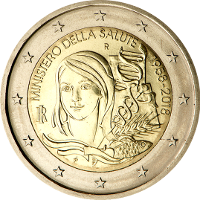
|
 |
Italy | 60th anniversary of the formation of the Ministry of Health | 20001 |  |
Volume : 3,000,000 Date of Issue : 05 Mar. 2018 Designer : Silvia Petrassi ("SP") Producer : Italian mint Istituto Poligrafico e Zecca dello Stato in Rome (Mintmark = "R") |
|||||

|
 |
Italy | 500th anniversary of Leonardo da Vinci's death | 20001 |  |
Volume : 3,000,000 Date of Issue : 25 Jan. 2019 Designer : Maria Angela Cassol ("M.A.C.") Producer : Italian mint Istituto Poligrafico e Zecca dello Stato in Rome (Mintmark = "R") |
|||||
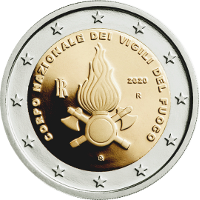
|
 |
Italy | 80th anniversary of the National Firefighters Corps | 20001 |  |
Volume : 3,000,000 Date of Issue : 20 Jan. 2020 Designer : Luciana De Simoni ("LDS") Producer : Italian mint Istituto Poligrafico e Zecca dello Stato in Rome (Mintmark = "R") |
|||||
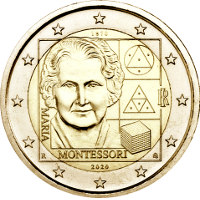
|
 |
Italy | 150th birthday of Maria Montessori | 20001 |  |
Volume : 3,000,000 Date of Issue : 09 Jun. 2020 Designer : Luciana De Simoni ("LDS") Producer : Italian mint Istituto Poligrafico e Zecca dello Stato in Rome (Mintmark = "R") |
|||||
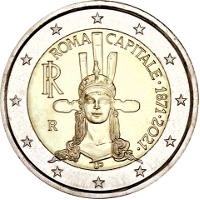
|
 |
Italy | 150th anniversary of the proclamation of Rome as the capital of Italy | 20001 |  |
Volume : 3,000,000 Date of Issue : 26 Jan. 2021 Designer : Uliana Pernazza (Logo "UP") Producer : Italian mint Istituto Poligrafico e Zecca dello Stato in Rome (Mintmark = "R") |
|||||
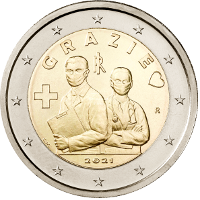
|
 |
Italy | Grazie ‐ Health professionals | 20001 |  |
Volume : 3,000,000 Date of Issue : 22 Jun. 2021 Designer : Claudia Momoni ("C.M.") Producer : Italian mint Istituto Poligrafico e Zecca dello Stato in Rome (Mintmark = "R") |
|||||
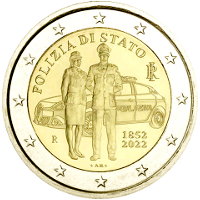
|
 |
Italy | 170th anniversary of the foundation of the Polizia di Stato | 20001 |  |
Volume : 3,000,000 Date of Issue : 06 Apr. 2022 Designer : Annalisa Masini ("A.M.") Producer : Italian mint Istituto Poligrafico e Zecca dello Stato in Rome (Mintmark = "R") |
|||||
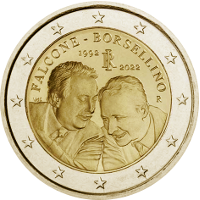
|
 |
Italy | 30th anniversary of the death of Giovanni Falcone and Paolo Borsellino | 20001 |  |
Volume : 3,000,000 Date of Issue : 17 May 2022 Designer : Valerio de Seta ("VdS.") Producer : Italian mint Istituto Poligrafico e Zecca dello Stato in Rome (Mintmark = "R") |
|||||
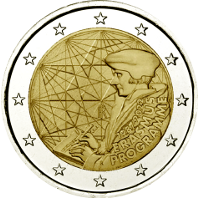
|
 |
Italy | 35th anniversary of the Erasmus Program | 20001 |
 |
Volume : 1,005,000 Date of Issue : 01 Jul. 2022 Designer : Joaquin Jimenez Producer : Italian mint Istituto Poligrafico e Zecca dello Stato in Rome (Mintmark = "R") |
|||||

|
 |
Italy | 100th anniversary of the Italian Air Force | 20001 |  |
Volume : 3,000,000 Date of Issue : 21 Mar. 2023 Designer : Valerio de Seta (Ligatur "VdS") Producer : Italian mint Istituto Poligrafico e Zecca dello Stato in Rome (Mintmark = "R") |
|||||
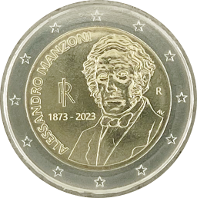
|
 |
Italy | 150th anniversary of the death of Alessandro Manzoni | 20001 |  |
Volume : 3,000,000 Date of Issue : 15 May 2023 Designer : Antonio Vecchio ("AV.") Producer : Italian mint Istituto Poligrafico e Zecca dello Stato in Rome (Mintmark = "R") |
|||||
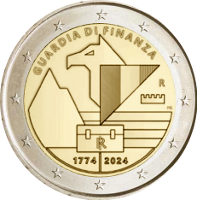
|
 |
Italy | 250th anniversary of the founding of the Guardia di financa corps | 20001 |  |
Volume : 3,000,000 Date of Issue : 12 Mar. 2024 Designer : Marta Bonifacio ("MB") Producer : Italian mint Istituto Poligrafico e Zecca dello Stato in Rome (Mintmark = "R") |
|||||
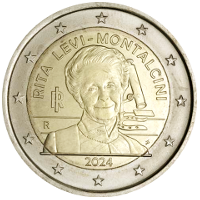
|
 |
Italy | Nobel laureate Rita Levi‐Montalcini | 20001 |  |
Volume : 3,000,000 Date of Issue : 22 Apr. 2024 Designer : Silvia Petrassi (Logo "SP") Producer : Italian mint Istituto Poligrafico e Zecca dello Stato in Rome (Mintmark = "R") |
|||||
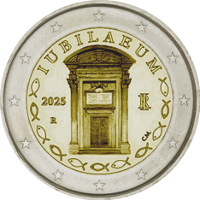
|
 |
Italy | Jubilee 2025 | 20001 |  |
Volume : 3,000,000 Date of Issue : 05 Feb. 2025 Designer : Claudia Momoni ("C.M.") Producer : Italian mint Istituto Poligrafico e Zecca dello Stato in Rome (Mintmark = "R") |
|||||
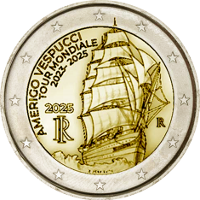
|
 |
Italy | World Tour of the School Ship Amerigo Vespucci 2023‐2025 | 20001 |  |
Volume : 3,000,000 Date of Issue : 09 May 2025 Designer : Emanuele Ferretti ("E.Ferretti") Producer : Italian mint Istituto Poligrafico e Zecca dello Stato in Rome (Mintmark = "R") |
|||||
| References : | |||
| 20001 | Images taken with authorisation by the ECB ‐ Mail dated 20.Feb.2020 © "European Central Bank" |
20002 | Not Applicable |
| 20003 | Images taken temporally from the Internet | 20004 | Not Applicable |
 |
